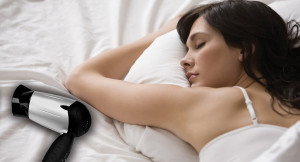Do Not Sleep with Your Hairdryer! (And Other Strange Warnings)
My father was a bit of a joker when I was a kid. “They’re coming to get you!” he’d say at the sound of police sirens in the distance. I developed a Pavlovian response to law enforcement and an excessive respect for authority as a result of his chiding. A look back on all of the ways I could have rebelled but didn’t is a glimpse into my misspent youth.
Take, for example, the tag on my pillow that decreed “Do not remove under penalty of law.” (This was before the important coda “except by the consumer” had been added.) I didn’t know why it was a crime to yank the tag off, but I kept it intact. But had I removed it in revolt, the cops wouldn’t have come for me.
In the early twentieth century, the ubiquitous pillow and mattress label was put in place to protect consumers from buying bedding that harbored pests or caused illness. Bedbugs and lice loved nothing more than to roost in horsehair, which was as common a filler as food waste, corn husks, or dirty rags. The tag law informed buyers that their product was new and its contents were safe, and was a necessary response to a manufacturing boom that had been churning out products of questionable integrity.
Manufacturing and its requisite labeling has since evolved. The sticker on a Huebsch washing machine warns “DO NOT put any person in this washer.” Although I’m curious about the person that would consider climbing inside, I’m more interested in the reason for such a warning. Of equal intrigue is a cocktail napkin with a nautical map of Hilton Head, South Carolina as its design. “Not to be used for navigation” reads the fine print, helpfully reminding yacht captains and sailors alike that it would be best if they relied on GPS and radar to steer clear of dry land and other maritime hazards.
Common sense dictates that you don’t turn on your hair dryer and bring it to bed with you. Yet tags that  read “Do not use while sleeping” are now affixed to the beauty appliance; apparently there’s at least one person who needs to heed the warning. Actually, an episode of the television show “My Strange Addiction” features a woman who began sleeping with her hair dryer as a child, the sound helping to soothe her asleep. Her dangerous habit has unsurprisingly resulted in arm and chest burns.
read “Do not use while sleeping” are now affixed to the beauty appliance; apparently there’s at least one person who needs to heed the warning. Actually, an episode of the television show “My Strange Addiction” features a woman who began sleeping with her hair dryer as a child, the sound helping to soothe her asleep. Her dangerous habit has unsurprisingly resulted in arm and chest burns.
Regardless of how ridiculous some labels may seem, there’s apparent reason for them. We’ve come a long way from the laws of last century that sought to protect consumers. In modern litigious society, tags and warnings are written just as much to defend manufacturers from potential or frivolous lawsuits as to caution the buyer.
You may recall the McDonald’s coffee case. In 1994, seventy-nine year old defendant Stella Liebeck was a passenger in her grandson’s car when she ordered a coffee from a drive-through. Accidentally spilling the cup in her lap, she suffered extensive burns and racked up more than $10,000 worth of medical expenses. In an effort to recoup the cost of her care, Liebeck tried to settle with the fast food chain for approximately $18,000, but was offered only $800.
That’s when grandma got real, lawyered up, and was ultimately awarded over $2 million, winning a product liability lawsuit against the corporate giant.
Given recent history and today’s marketplace, the current warning on a cup McDonald’s coffee, “Caution Handle with Care I’m Hot” is an exercise in editorial restraint.
Heather Candon is a writer living in New York.

